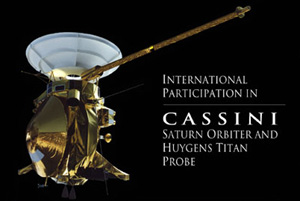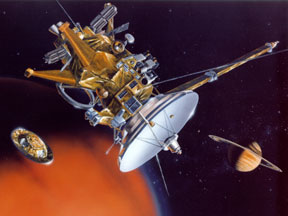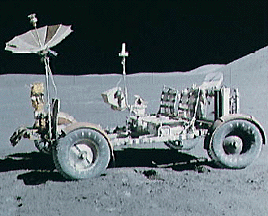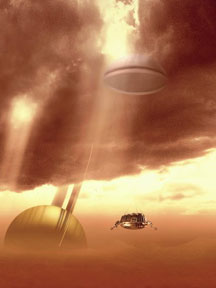This is what an artist thinks Huygens will look like in Titan's atmosphere. The Huygens probe is hanging from its parachute. You can see the planet Saturn in the sky in the background.
Click on image for full size
Image courtesy ESA.
Huygens Probe to Titan
A robot spaceship landed on the biggest moon of the planet
Saturn in January 2005. The spaceship was named Huygens. Huygens landed on
the moon Titan on January 14, 2005.
Huygens had been riding on the side of another spaceship for seven
years.
NASA's Cassini spacecraft carried Huygens
to Saturn from Earth. Cassini "let
go" of Huygens on December 24, 2004.
Huygens studied the atmosphere
of Titan. Parachutes on Huygens lowered
it through Titan's atmosphere. Then Huygens landed on Titan. The surface of Titan is very, very cold. The temperature there is
about -178º C (-288º F)!
The spaceship was named after Christiaan
Huygens. Christiaan Huygens was a Dutch astronomer. He discovered Titan in
1655.
You might also be interested in:

Cassini is on its way to Saturn. It will take the Cassini spacecraft over 6 years to get to Saturn. Cassini was launched on a rocket early in the morning on October 15. The Cassini spacecraft is a big
...more
Cassini is the name of a robot spacecraft. Cassini is studying the planet Saturn. It is also studying many of Saturn's moons and Saturn's cool rings. Cassini blasted off from Earth in 1997. It took Cassini
...more
A spacecraft named Cassini is orbiting around the planet Saturn right now. Cassini carried another, smaller robot space probe with it on its long trip from Earth. The smaller probe is named Huygens. Huygens
...more
The Hubble Space Telescope (HST) is really neat! It was first launched in 1990, but scientists started building it in the 1970's! We have found all kinds of objects like stars, nebulae and galaxies. The
...more
Apollo 11 was the first mission that landed a person on the moon. On July 16, 1969, the U. S. rocket Saturn 5 was launched carrying the lunar landing module Eagle. The Eagle was released and it reached
...more
Apollo 12 was launched on Nov. 14, 1969 and arrived at the Moon three days later. Astronauts Charles Conrad and Alan Bean descended to its surface, while Richard Gordon remained in lunar orbit aboard the
...more
Apollo 15 marked the start of a new series of missions from the Apollo space program, each capable of exploring more lunar terrain than ever before. Launched on July 26, 1971, Apollo 15 reached the Moon
...more














